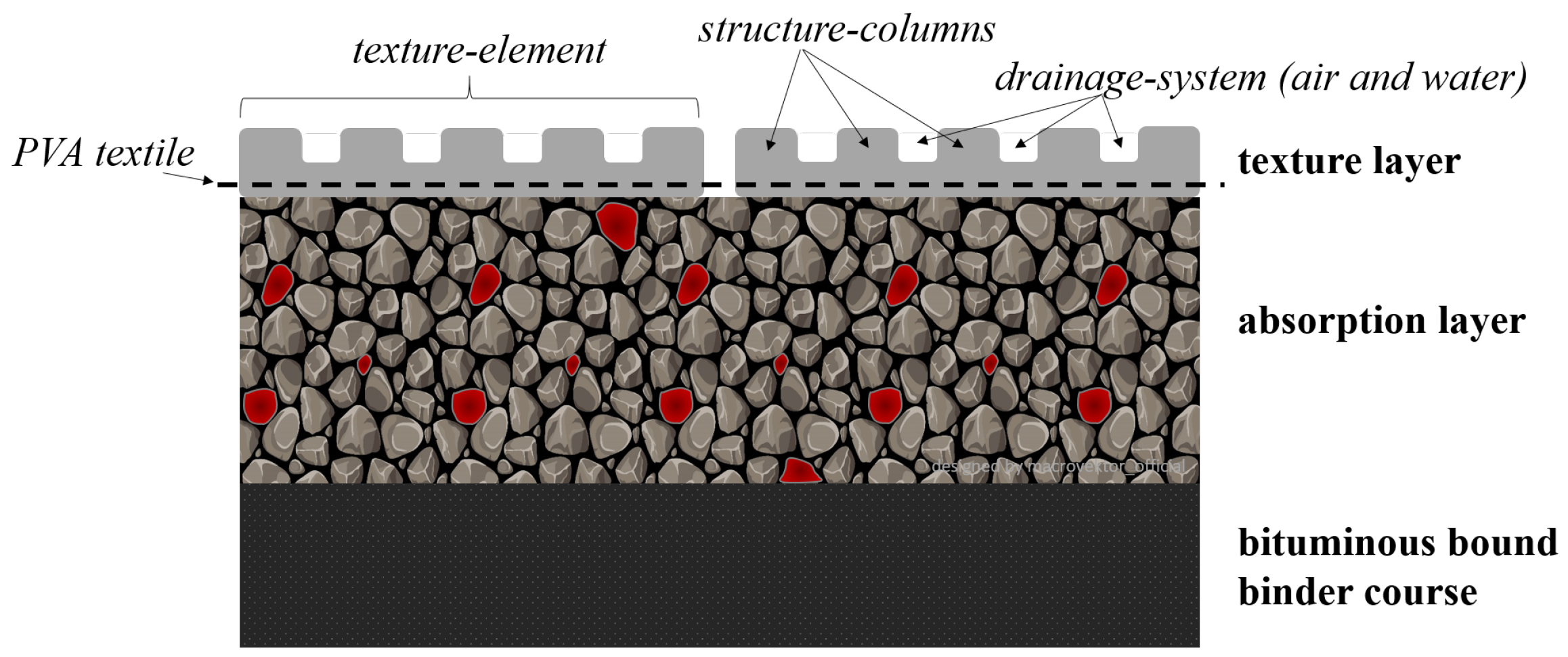Assessing the Durability and Acoustic Performance of a Novel Two-Layer Pavement System
Abstract
:1. Introduction
2. Materials and Methods
2.1. Production of the Absorption and Texture Layer
2.2. Preparation of the Texture Layer Plates
2.3. Methodology
2.4. Laboratory Study
2.4.1. Skid Resistance Test
2.4.2. Aachen Ravelling Test
2.4.3. Wheel Tracking Test
2.4.4. Shear Bond Strength Test
2.4.5. Tensile Bond Strength Test
2.4.6. Permeability Test
2.5. Large Scale Study
2.5.1. Sound Absorption Measurements
2.5.2. Accelerated Pavement Testing
2.5.3. Deflection Measurements
2.5.4. Skid Resistance Measurements
3. Results and Discussion
3.1. Results of the Experimental Study on a Laboratory Scale
3.1.1. Skid Resistance of the Texture Layer
3.1.2. Analysis of the Interlayer Bond of the Texture Layer and the Absorption Layer
3.1.3. Rutting Behavior of the Noise-Reducing Two-Layer System
3.1.4. Testing the Application of the Two-Layer System on Conventional Bituminous Bottom Layers
3.2. Implementation of the Large Scale Demonstrator
3.2.1. Location and Conditions of the Test Section
3.2.2. Paving of the Absorption Layer
3.2.3. Grinding of the Absorption Layer
3.2.4. Prefabrication of the Texture Layer Plates
3.2.5. Application of the Texture Layer on the Absorption Layer
3.3. Results of the Full-Scale Experiments
3.3.1. Analysis of the Acoustic Performance
3.3.2. Analysis of Accelerated Pavement Testing
4. Conclusions
Author Contributions
Funding
Institutional Review Board Statement
Informed Consent Statement
Data Availability Statement
Acknowledgments
Conflicts of Interest
Abbreviations
| ARTe | Aachen Ravelling Tester |
| BE | Bitumen emulsion |
| CPX | Close Proximity Method |
| FWD | falling weight deflectometer |
| GN | Grip Number |
| HMA | Hot Mix Asphalt |
| k | permeability coefficient |
| MA | Mastic asphalt |
| MLS 30 | Mobile Load Simulator |
| PU | Polyurethane |
| PVA | Poly-Vinyl-Alcohol |
| SBST | Shear Bond Strength Test |
| SRT | Skid Resistance Tester |
| TAT | Tensile Bond Strength Test |
| WTT | wheel tracking test |
Appendix A
| Component | Proportion | Company, Location, Country | |
|---|---|---|---|
| *1 | methyl methacrylate (PMMA) | 25% | Röhm GmbH, Darmstadt, Germany |
| *2 | silica sand filler (< 1 mm) (MinMix AT530) | 75% | Quarzwerke GmbH, Frechen, Germany |
| *3 | add. of 1% dibenzoyl peroxide (Swarco Limburger Lackfabrik GmbH, Diez, Germany) | ||
| Component | Proportion | Company, Location, Country | |
|---|---|---|---|
| *4 | crump rubber super grob (2–6 mm) | 7.5 vol.-% | Genan GmbH, Dorsten, Germany |
| *5 | basalt aggregates (2–5 mm) | 85.5 vol.-% | Basalt Quarry Hühnerberg, Königswinter, Germany |
| *5 | basalt sand (0–2 mm) | 3 vol.-% | Basalt Quarry Hühnerberg, Königswinter, Germany |
| *6 | limestone filler | 4 vol-% | Kalkwerk-Natursteinwerke GmbH und Co. KG, Üxheim-Ahütte, Germany |
| *7 | addition of 13 vol.-% of polyurethane binder (Elastan 3538/103) | ||
References
- Straßen in Deutschland. Available online: https://de.statista.com/statistik/studie/id/12547/dokument/strassen-in-deutschland-statista-dossier/ (accessed on 31 October 2023).
- Wothge, J. Die Körperlichen und Psychischen Wirkungen von Lärm. UMID 01/2016 2016, 38–43. Available online: https://www.umweltbundesamt.de/sites/default/files/medien/2218/publikationen/umid_1_2016_uba_laerm.pdf (accessed on 4 November 2023).
- Gogolin, D. Rheologische Kennwerte Bitumenhaltiger Bindemittel zur Charakterisierung Akustischer Eigenschaften von Asphaltdeckschichten. Ph.D. Thesis, Ruhr University Bochum, Bochum, Germany, 2012. [Google Scholar]
- Peschel, U.; Reichart, U.; Bartholomaeus, W.; Ripke, O.; Stöckert, U.; Zöller, M. Lärmmindernde Fahrbahnbeläge. Ein Überblick über den Stand der Technik; Umweltbundesamt: Dessau-Roßlau, Germany, 2014; pp. 18–32. [Google Scholar]
- Sandberg, U.; Ejsmont, J.A. Tyre/Road Noise Reference Book, 1st ed.; INFORMEX: Kisa, Sweden, 2002. [Google Scholar]
- Goubert, L.; Sandberg, U. Construction and Performance of Poroelastic Road Surfaces Offering 10 dB of Noise Reduction—PERSUADE Final Technical Report; Belgian Road Research Centre (BRRC) and Swedish National Road and Transport Research Institute (VTI): Woluwe-Saint-Lambert, Belgium, 2016. [Google Scholar]
- Renken, L. Development of PU-Asphalt: From the Concept to the Practical Implementation. Ph.D. Thesis, RWTH Aachen University, Aachen, Germany, 2019. [Google Scholar]
- Schacht, A. Entwicklung Künstlicher Straßendeckschichtsysteme auf Kunststoffbasis zur Geräuschreduzierung mit Numerischen und Empirischen Verfahren. Ph.D. Thesis, RWTH Aachen University, Aachen, Germany, 2015. [Google Scholar]
- Beckenbauer, T. Physik der Reifen-Fahrbahn-Geräusche—Geräuschentstehung, Wirkungsmechanismen und Akustische Wirkung unter dem Einfluss von Bautechnik und Straßenbetrieb. In Proceedings of the 4. Informationstage—Geräuschmindernde Fahrbahnbeläge in der Praxis-Lärmaktionsplanung, Planegg, Germany, 11–12 June 2008. [Google Scholar]
- Yoder, E.J.; Witczak, M.W. Principles of Pavement Design, 2nd ed.; John Wiley & Sons, Inc.: Hoboken, NJ, USA, 1975. [Google Scholar]
- Faßbender, S.; Oeser, M. Investigation on an Absorbing Layer Suitable for a Noise-Reducing Two-Layer Pavement. Materials 2020, 13, 1235. [Google Scholar] [CrossRef] [PubMed]
- Faßbender, S.; Oeser, M.; Eggersmann, R.; Reese, S.; Koch, A.; Gries, T.; Pieroth, M.; Klein, A. Development of 843 a novel polymer-based road surface layer with focus on noise reduction and durability. Bauingenieur 2022, 10, 323–330. [Google Scholar] [CrossRef]
- Baur, E.; Brinkmann, S.; Osswald, T.; Rudolph, N.; Schmachtenberg, E. Saechtling Kunststoff Taschenbuch, 31st ed.; Carl Hanser Verlag: Munich, Germany, 2013. [Google Scholar]
- DIN EN 13036-4:2011; Road and Airfield Surface Characteristics—Test Methods—Part 4: Method for Measurement of Slip/Skid Resistance of a Surface—The Pendulum Test. Beuth Verlag GmbH: Berlin, Germany, 2011.
- DIN EN 12697-48:2021; Bituminous Mixtures—Test Methods—Part 48: Interlayer Bonding. Beuth Verlag GmbH: Berlin, Germany, 2021.
- DIN EN 12697-22:2020; Bituminous Mixtures—Test Methods—Part 22: Wheel Tracking. Beuth Verlag GmbH: Berlin, Germany, 2022.
- DIN EN ISO 11819-2:2017-10; Acoustics—Measurement of the Influence of Road Surfaces on Traffic Noise—Part 2: The Close-Proximity Method. Beuth Verlag GmbH: Berlin, Germany, 2017.
- Wacker, B. Zeitraffende Belastungsversuche mit Integriertem Einsatz zerstöRungsfreier Messverfahren—Entwicklung eines Kontinuierlich Messenden Structure Measurement Systems zur Detektion von Veränderungen im Aufbau. Ph.D. Thesis, Ruhr University Bochum, Bochum, Germany, 2020. [Google Scholar]
- DIN EN 12697-50:2018; Bituminous Mixtures—Test Methods—Part 50: Resistance to Scuffing. Beuth Verlag GmbH: Berlin, Germany, 2018.
- Wang, D. Schaffung des Bewertungshintergrunds zur Charakterisierung des Polierverhaltens der Einzelnen, Gesteinsbildenden Minerale und zur Untersuchung des Griffigkeitsverhaltens der Mineralaggregate in Abhängigkeit von den Polierbedingungen. Ph.D. Thesis, RWTH Aachen University, Aachen, Germany, 2011. [Google Scholar]
- DIN EN 12697-19:2020; Bituminous Mixtures—Test Methods—Part 19: Permeability of Specimen. Beuth Verlag GmbH: Berlin, Germany, 2018.
- Wacker, B.; Scherkenbach, M.; Rabe, R.; Golkowski, G. Belastungseinrichtung Mobile Load Simulator MLS30—Sensorik zur Beanspruchungsdetektion im Ersten Gemeinsamen Versuchsbetrieb. In Reports of the Federal Highway Institute; Fachverlag NW in der Carl Schuenemann Verlag GmbH: Bremen, Germany, 2016; Volume S101. [Google Scholar]
- Forschungsgesellschaft für Straßen- und Verkehrswesen (FGSV). Arbeitspapier Tragfähigkeit von Verkehrsflächenbefestigungen Teil A: Messsysteme (AP Trag Teil A) (FGSV 433 A); FGSV Verlag: Köln, Germany, 2020. [Google Scholar]
- Jendia, S. Bewertung der Tragfähigkeit von Bituminösen Straßenbefestigungen. Ph.D. Thesis, University of Karlsruhe, Karlsruhe, Germany, 1995. [Google Scholar]
- Wolf, A.; Schickl, W. Restnutzungsdauer von Asphaltschichten—Prüfung der Grundlagen zu ihrer Berechnung. In Reports of the Federal Highway Institute; Fachverlag NW in der Carl Schuenemann Verlag GmbH: Bremen, Germany, 1998; Volume S17. [Google Scholar]
- Rasol, M.; Schmidt, F.; Ientile, S.; Adelaide, L.; Nedjar, B.; Kane, M.; Chevalier, C. Progess and Monitoring Opportunities of Skied Resistance on Road Transport: A Critical Review and Road Sensors. Remote Sens. 2021, 13, 3729. [Google Scholar] [CrossRef]
- Managing Your Network for Skid Resistance Micro GripTester (µGT)—Data Sheet. Available online: https://www.mastrad.com/microgt.pdf (accessed on 2 October 2023).
- BS 7941-2:2000; Methods for Measuring the Skid Resistance of Pavement Surfaces—Test Method for Measurement of Surface Skid Resistance Using the GripTester Braked Wheel Fixed Slip Device. BSI Group: London, UK, 2000.
- Forschungsgesellschaft für Straßen- und Verkehrswesen (FGSV). Merkblatt zur Bewertung der Straßengriffigkeit bei Nässe (M BGriff) (FGSV 401); FGSV Verlag: Köln, Germany, 2012. [Google Scholar]
- Forschungsgesellschaft für Straßen- und Verkehrswesen (FGSV). Technische Prüfvorschriften für Asphalt (TP Asphalt-StB) Teil 80: Abscherversuch (FGSV 756/80); FGSV Verlag: Köln, Germany, 2012. [Google Scholar]
- Tsai, B.-W.; Coleri, E.; Harvey, J.T.; Monismith, C.L. Evaluation of AASHTO T 324 Hamburg-Wheel Track Device test. Constr. Build. Mater. 2016, 114, 248–260. [Google Scholar] [CrossRef]
- T 324; Standard Method of Test for Hamburg Wheel-Track Testing of Compacted Hot-Mix Asphalt (HMA). AASHTO: Washington, DC, USA, 2023.
- Oeser, M.; Faßbender, S.; Reese, S.; Eggersmann, R.; Gries, T.; Koch, A. Grundlagen der konstruktiven Gestaltung, Struktur sowie neuer polymerer Werkstoffe für Straßendeckschichtsysteme. In Grundlegende Erforschung Polymerer Werkstoffe Sowie Innovativer Herstellungs- und Einbautechnologien für Straßendeckschichtsysteme; RWTH Aachen University: Aachen, Germany, 2019. [Google Scholar]
- Varallyay, G.; Legarth, S.V.; Ramirez, T. Music Lovers and Hearing Aids. Available online: https://www.audiologyonline.com/articles/music-lovers-and-hearing-aids-16478 (accessed on 21 November 2023).
- Cesbron, J.; Bianchetti, S.; Pallas, M.A.; Pratico, F.G.; Fedele, R.; Pellicano, G.; Moro, A.; Bianco, F. Acoustical characterization of low-noise prototype asphalt concretes for electric vehicles. In Proceedings of the Euronoise 2021, Madere, Portugal, 25–27 October 2021. [Google Scholar]
- Seipel, G. Analyse der Einflussgrößen auf die Entstehung und Intensität von Reifenspuren. Ph.D. Thesis, Technical University of Darmstadt, Darmstadt, Germany, 2013. [Google Scholar]
- Rodrigues de Andrade, L.; Bessa, I.S.; Vasconcelos, K.L.; Bariani Bernucci, L.L.; Suzuki, C.Y. Structural Performance Using Deflection Basin Parameters of Asphalt Pavements with Different Base Materials Under Heavy Traffic. Int. J. Pavement Res. Technol. 2023, 1–14. [Google Scholar] [CrossRef]
- Forschungsgesellschaft für Straßen- und Verkehrswesen (FGSV). Arbeitspapier—Tragfähigkeit für Verkehrsflächenbefestigungen Teil C 2.1 Falling Weight Deflectometer (FWD): Auswertung und Bewertung—Asphaltbauweise (AP Trag Teil C 2.1) (FGSV 433 C 2.1); FGSV Verlag: Köln, Germany, 2014. [Google Scholar]
- Forschungsgesellschaft für Straßen- und Verkehrswesen (FGSV). Richtlinien für die Standardisierung des Oberbaus von Verkehrsflächen (RStO) (FGSV 499); FGSV Verlag: Köln, Germany, 2012. [Google Scholar]


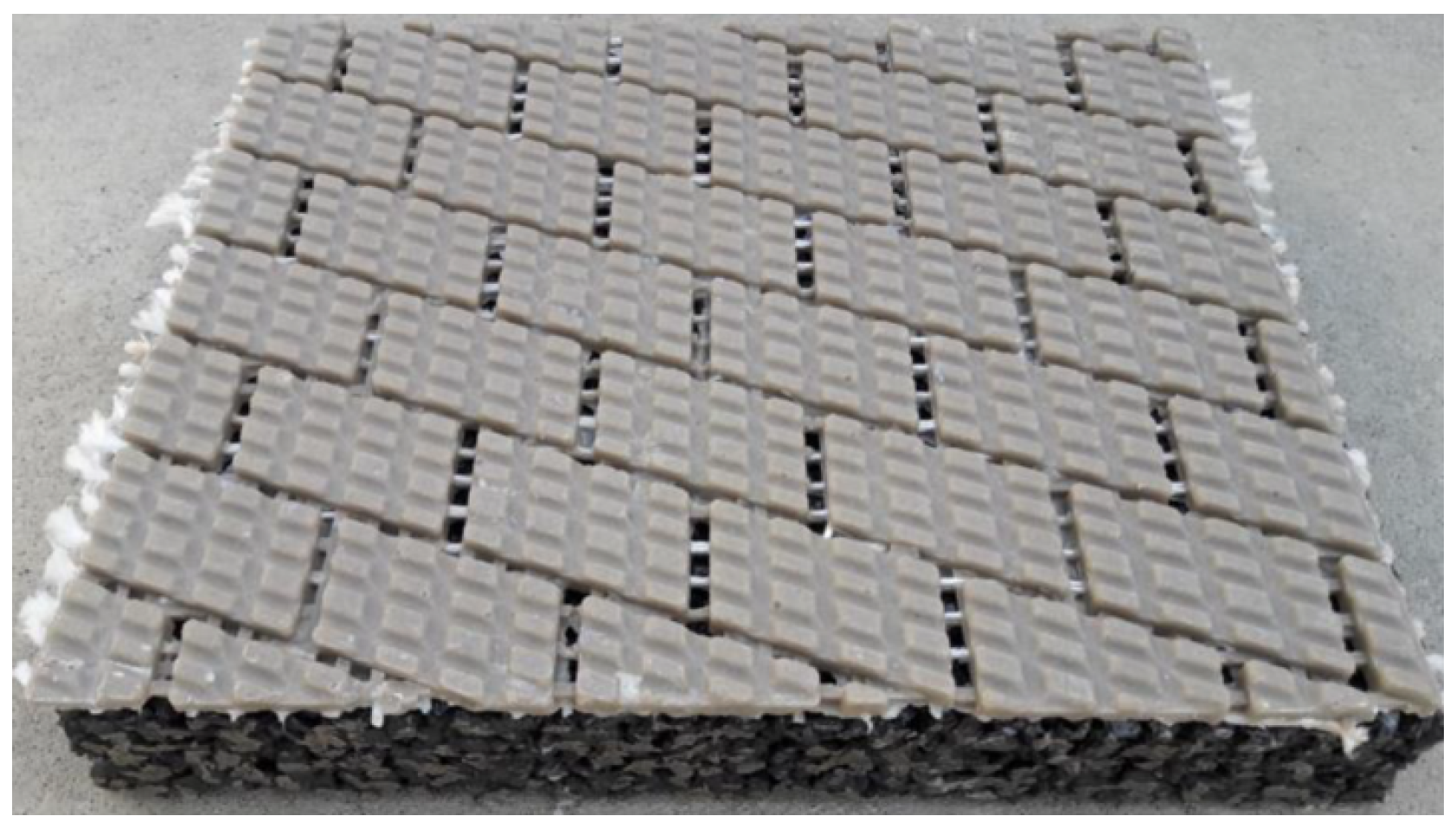


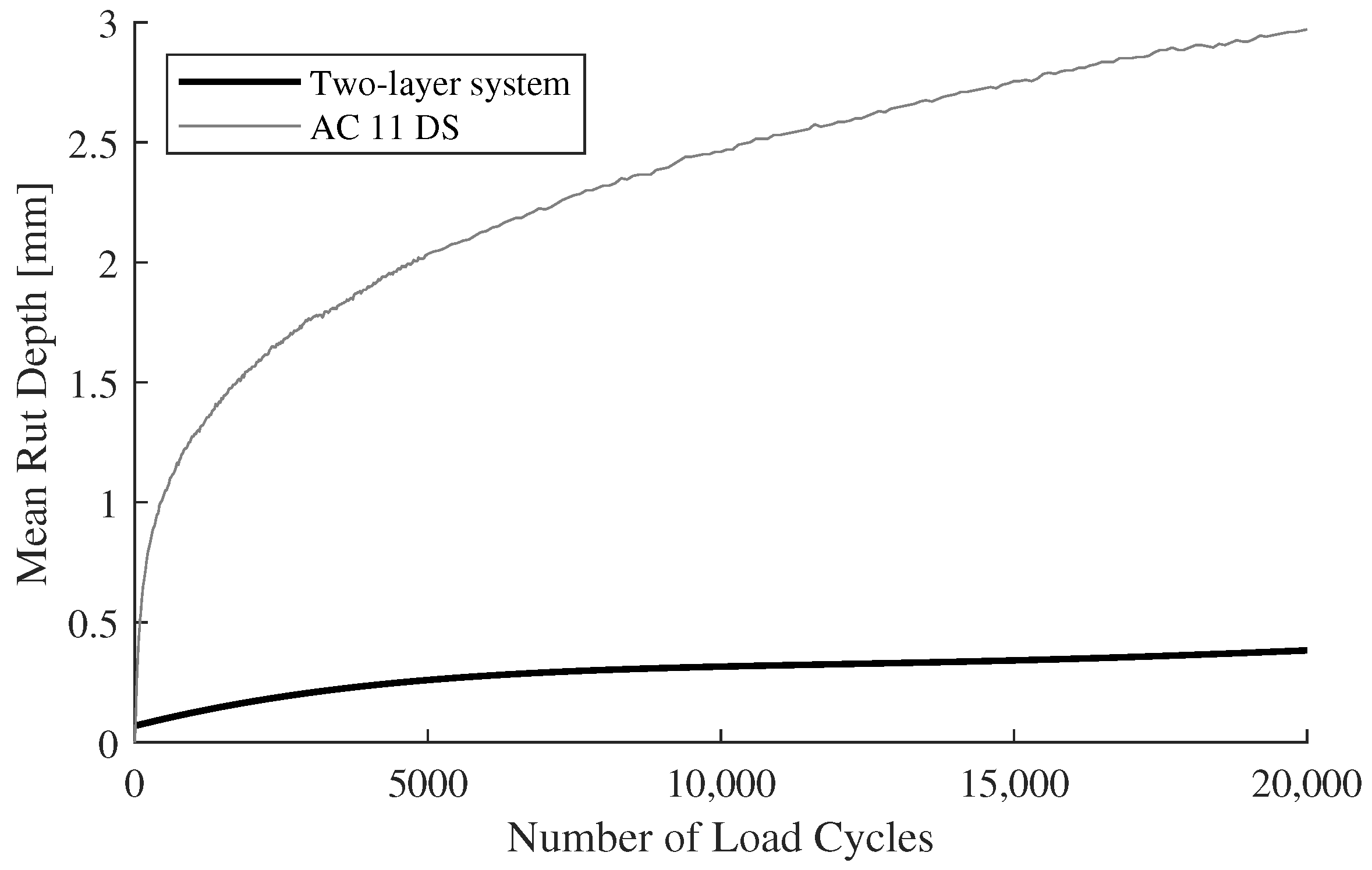

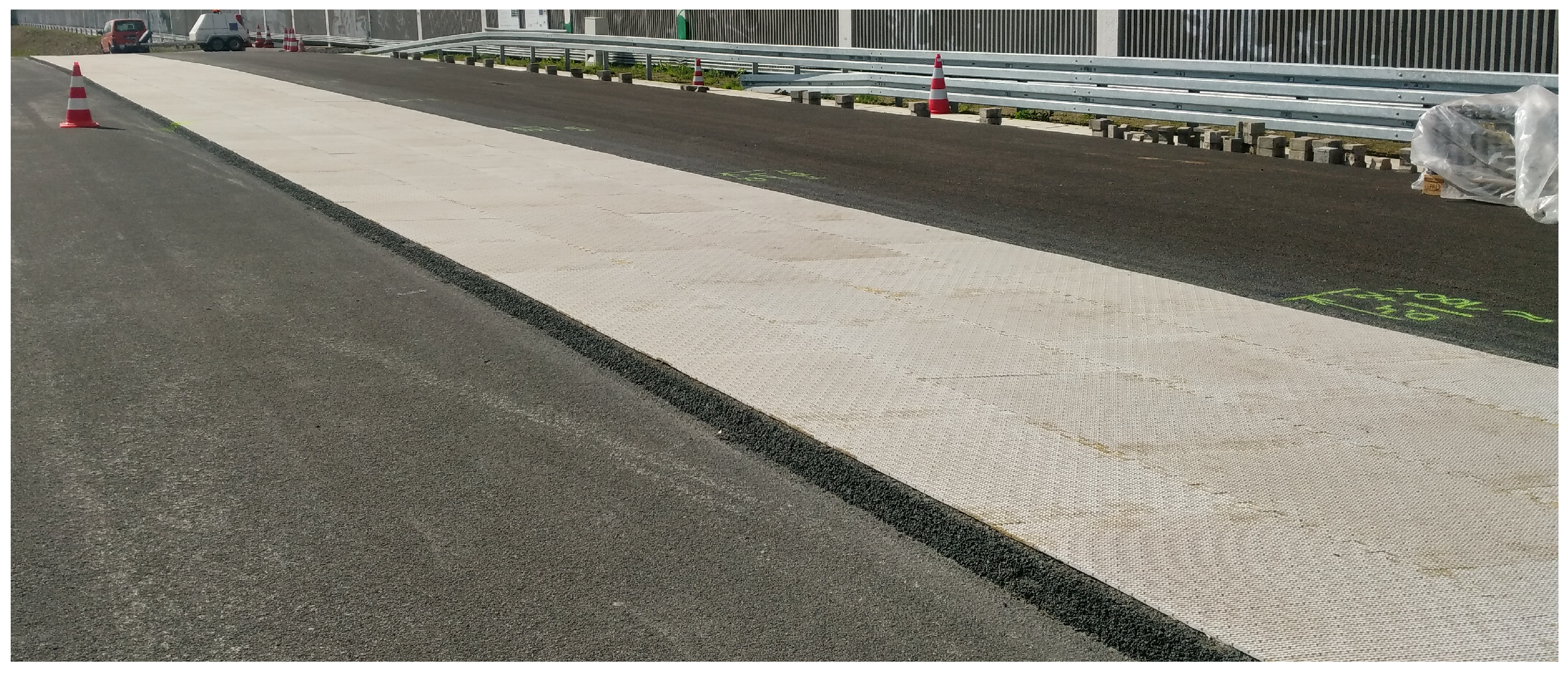
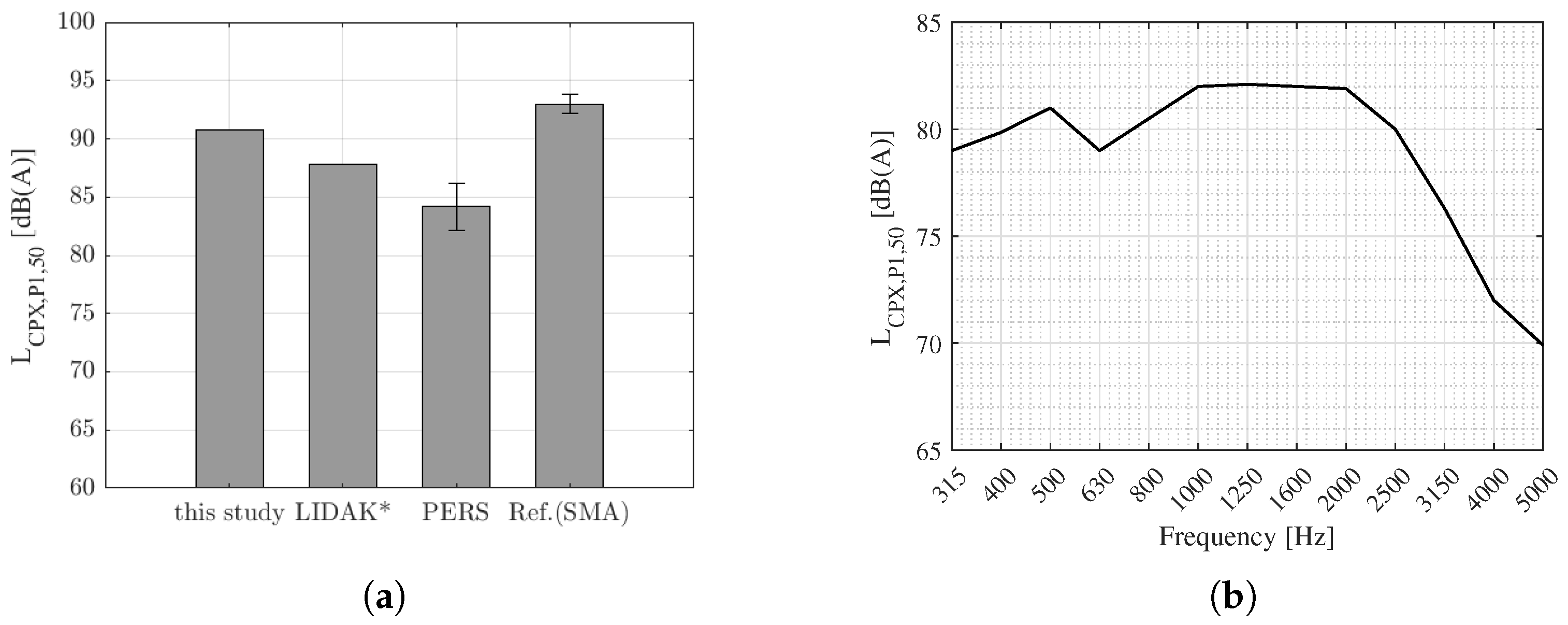



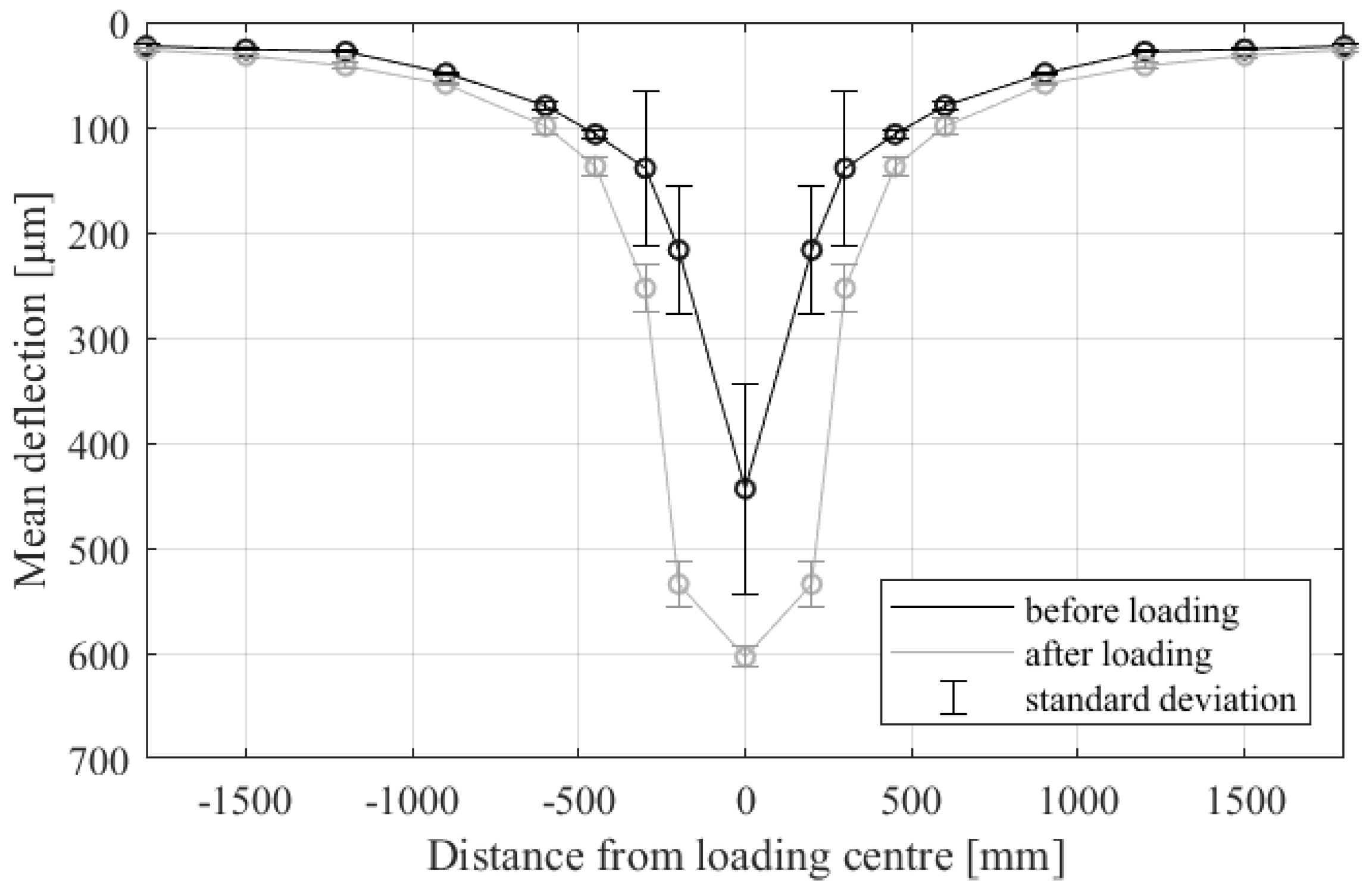
| Variant | Var 1 | Var 2 | Var 3 | Var 3.1 | Var 3.2 |
|---|---|---|---|---|---|
| absorption layer | fresh | fresh | prefab. | prefab. | prefab. |
| binder content [wt.-%] | 6.3 | 8.3 | 6.3 | 6.3 | 6.3 |
| top layer | prefab. | prefab. | prefab. | prefab. | prefab. |
| adhesive [g] | 0 | 0 | 30 | 20 | 10 |
| adhesive [g/m2] | 0 | 0 | 1695 | 1130 | 565 |
Disclaimer/Publisher’s Note: The statements, opinions and data contained in all publications are solely those of the individual author(s) and contributor(s) and not of MDPI and/or the editor(s). MDPI and/or the editor(s) disclaim responsibility for any injury to people or property resulting from any ideas, methods, instructions or products referred to in the content. |
© 2023 by the authors. Licensee MDPI, Basel, Switzerland. This article is an open access article distributed under the terms and conditions of the Creative Commons Attribution (CC BY) license (https://creativecommons.org/licenses/by/4.0/).
Share and Cite
Tekampe, S.; Oeser, M. Assessing the Durability and Acoustic Performance of a Novel Two-Layer Pavement System. Sustainability 2023, 15, 16475. https://doi.org/10.3390/su152316475
Tekampe S, Oeser M. Assessing the Durability and Acoustic Performance of a Novel Two-Layer Pavement System. Sustainability. 2023; 15(23):16475. https://doi.org/10.3390/su152316475
Chicago/Turabian StyleTekampe, Sabine, and Markus Oeser. 2023. "Assessing the Durability and Acoustic Performance of a Novel Two-Layer Pavement System" Sustainability 15, no. 23: 16475. https://doi.org/10.3390/su152316475






